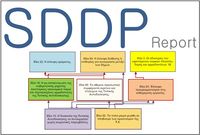SDDP COST 219ter Obstacles to practical broadband applications: Difference between revisions
No edit summary |
No edit summary |
||
| Line 10: | Line 10: | ||
|stats=Participants=21 <br> Number of ideas=55 <br>Number of Clusters=18 <br> Ideas received Votes=23 <br> Ideas on MAP R=19 <br>Spreathink ST=40% | |stats=Participants=21 <br> Number of ideas=55 <br>Number of Clusters=18 <br> Ideas received Votes=23 <br> Ideas on MAP R=19 <br>Spreathink ST=40% | ||
|dates=16th - 17th February 2010 | |dates=16th - 17th February 2010 | ||
|link=[[ | |link=[[Cost219terBook Ch7 LaourisMichaelides.pdf Download Report]] | ||
}} | }} | ||
| Line 20: | Line 20: | ||
<u>The [[Triggering Question]] (TQ) was </u><br> | <u>The [[Triggering Question]] (TQ) was </u><br> | ||
''' | '''Considering the availability of powerful broadband technologies and the development of relevant scenarios, what are the obstacles that prevent us from producing practical applications?''' | ||
In response to the TQ, the 21 participants came up with 55 mechanisms, which were categorized in 10 clusters. Following the voting process, 37 ideas received one or more votes and were structured to create the influence MAP shown below. <br> | In response to the TQ, the 21 participants came up with 55 mechanisms, which were categorized in 10 clusters. Following the voting process, 37 ideas received one or more votes and were structured to create the influence MAP shown below. <br> | ||
Revision as of 07:54, 26 August 2013
|
Executive Summary
This report has been developed in the context of the COST 219ter: Accessibility for all to services and terminals for next generation mobile networks project (FP7 - Coordinating Action: Grant Agreement 248582). The goal of the project is to create a platform that can bring together the various stakeholders in the area of accessible and assistive ICT with a view to identifying Research & Development gaps and emerging trends and generating a research agenda roadmap.
The Triggering Question (TQ) was
Considering the availability of powerful broadband technologies and the development of relevant scenarios, what are the obstacles that prevent us from producing practical applications?
In response to the TQ, the 21 participants came up with 55 mechanisms, which were categorized in 10 clusters. Following the voting process, 37 ideas received one or more votes and were structured to create the influence MAP shown below.
According to the participants of this workshop, the characteristics appear to be the most influential were:
- Mechanism #1, Big delay in decision making from the governmental side
The participants had time to discuss and reflect on the influence map and in general agreed that the arrows in the map made sense to them. In sum, the participants reported their satisfaction that their voices have been heard and documented and communicated their expectations for follow-up activities to address the diagnosis of their needs.
The workshop was facilitated by Elena Aristodemou (CNTI), Aleco Christakis and Georgina Siitta Achilleos (CNTI).
